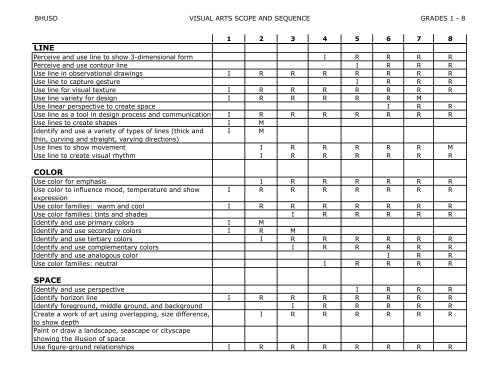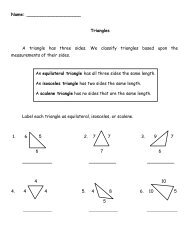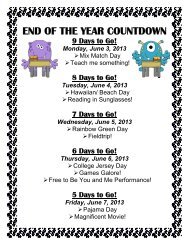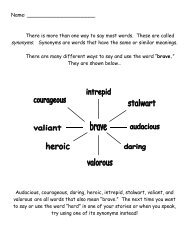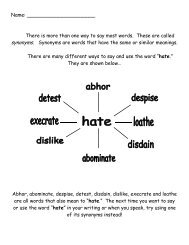K-8 Art Benchmarks - Scope and Sequence.pdf
K-8 Art Benchmarks - Scope and Sequence.pdf
K-8 Art Benchmarks - Scope and Sequence.pdf
You also want an ePaper? Increase the reach of your titles
YUMPU automatically turns print PDFs into web optimized ePapers that Google loves.
BHUSD VISUAL ARTS SCOPE AND SEQUENCE GRADES 1 - 8<br />
1 2 3 4 5 6 7 8<br />
LINE<br />
Perceive <strong>and</strong> use line to show 3-dimensional form I R R R R<br />
Perceive <strong>and</strong> use contour line I R R R<br />
Use line in observational drawings I R R R R R R R<br />
Use line to capture gesture I R R R<br />
Use line for visual texture I R R R R R R R<br />
Use line variety for design I R R R R R M<br />
Use linear perspective to create space I R R<br />
Use line as a tool in design process <strong>and</strong> communication I R R R R R R R<br />
Use lines to create shapes I M<br />
Identify <strong>and</strong> use a variety of types of lines (thick <strong>and</strong> I M<br />
thin, curving <strong>and</strong> straight, varying directions)<br />
Use lines to show movement I R R R R R M<br />
Use line to create visual rhythm I R R R R R R<br />
COLOR<br />
Use color for emphasis I R R R R R R<br />
Use color to influence mood, temperature <strong>and</strong> show I R R R R R R R<br />
expression<br />
Use color families: warm <strong>and</strong> cool I R R R R R R R<br />
Use color families: tints <strong>and</strong> shades I R R R R R<br />
Identify <strong>and</strong> use primary colors I M<br />
Identify <strong>and</strong> use secondary colors I R M<br />
Identify <strong>and</strong> use tertiary colors I R R R R R R<br />
Identify <strong>and</strong> use complementary colors I R R R R R<br />
Identify <strong>and</strong> use analogous color I R R<br />
Use color families: neutral I R R R R<br />
SPACE<br />
Identify <strong>and</strong> use perspective I R R R<br />
Identify horizon line I R R R R R R R<br />
Identify foreground, middle ground, <strong>and</strong> background I R R R R R<br />
Create a work of art using overlapping, size difference, I R R R R R R<br />
to show depth<br />
Paint or draw a l<strong>and</strong>scape, seascape or cityscape<br />
showing the illusion of space<br />
Use figure-ground relationships I R R R R R R R
BHUSD VISUAL ARTS SCOPE AND SEQUENCE GRADES 1 - 8<br />
Use atmospheric prerspective I R<br />
Use positive <strong>and</strong> negative space I R R R R<br />
Create the illusion of visual mass I R R R R<br />
SHAPE AND FORM<br />
Identify <strong>and</strong> use geometric shapes I R R R R R R<br />
Identify <strong>and</strong> use organic shpes I R R R<br />
Differentiate between two-dimensional shape <strong>and</strong> I R R R R R R R<br />
three-dimentional form<br />
Describe the concept of proportion, applied to the I R R R R<br />
face <strong>and</strong> figure, as used in art.<br />
TEXTURE<br />
Identify tactile or visual texture in life I R R R R R R R<br />
Create texture with line <strong>and</strong> color two-dimensionally I R R R R R R R<br />
Create texture with line <strong>and</strong> color three-dimensionally I R R R R R R R<br />
Use texture to create emphasis I R R R R R<br />
Use texture for design I R R R R R R R<br />
Use texture in two-dimensional art for emphasis <strong>and</strong> I R R R R R R<br />
design<br />
Use texture in three-dimensional art for emphasis <strong>and</strong> I R R R R R R<br />
design<br />
Identify texture in man-made <strong>and</strong> natural forms I R R R R R R<br />
BALANCE<br />
Identify <strong>and</strong> use symmetrical balance I R R R R R R<br />
Identify <strong>and</strong> use asymmetrical balance I R R R R<br />
Identify <strong>and</strong> use radial balance I R R<br />
Achieve balance in a work of art I R R<br />
VALUE<br />
Use value to suggest three-dimensional form I R R R R R R<br />
Use a range of values I R R<br />
Use value to describe light source I R<br />
PATTERN/RHYTHM<br />
Create pattern using repetition of lines, shapes, colors I R R R R R R R
BHUSD VISUAL ARTS SCOPE AND SEQUENCE GRADES 1 - 8<br />
Identify <strong>and</strong> use pattern I R R R R R R R<br />
Identify <strong>and</strong> use rhythm I R R R R R<br />
Identify <strong>and</strong> use emphnasis I R R R R<br />
Use rhythm to create visual movement I R R R R R<br />
UNITY/CONTRAST/EMPHASIS/HARMONY<br />
Create unity using proximity, repetition, or I R R R<br />
continuation of elements<br />
Identify unity <strong>and</strong> harmony in works of art I R R R<br />
Identify <strong>and</strong> use visual emphasis in a work of art I R R R R R<br />
Perceive <strong>and</strong> describe emphasis <strong>and</strong> contrast in art I R R R R<br />
SKILLS AND CRAFTSMANSHIP WITH MATERIALS, TOOLS, AND TECHNIQUES<br />
Mix <strong>and</strong> modify colors I R R R R R R R<br />
Use brush technuiques to create texture I R R R R R<br />
Use pinch technique in clay modeling I R R R R R R R<br />
Use coil technique in clay modeling I R R R R R R R<br />
Use slab forming technique in clay modeling I R R R R<br />
Use wet in dry painting technique I R R R R R R R<br />
Use wet in wet painting technique I R R R R R<br />
Use printing, rubbing, collage techniques I R R R R R R<br />
Use oil pastels, watercolor <strong>and</strong> tempera I R R R R R R<br />
Use tempera paints to create tints, shades <strong>and</strong> neutral I R R R R R<br />
colors<br />
Use sgraffito technique I R R R R<br />
Use scumbling <strong>and</strong> drybrushing techniques<br />
I<br />
Use additive <strong>and</strong> reductive techniques in sculptures I R R R R<br />
Use incising techniques I R R R R R R R<br />
Use papier mache techniques I R R R R R R R<br />
Use clay glazing techniques I R R R R R R R<br />
HISTORICAL AND CULTURAL CONTEXT<br />
Underst<strong>and</strong> ways that history <strong>and</strong> culture influence art I R R R R R R R<br />
Analyze specific influences of history <strong>and</strong> culture on art I R R R R R R R<br />
Underst<strong>and</strong> ways that art influences history <strong>and</strong> culture I R R R R R R R<br />
Analyze cultural impacts of artists <strong>and</strong> art I R R<br />
movements<br />
Compare various works of art with a similar, created at I R R R R R
BHUSD VISUAL ARTS SCOPE AND SEQUENCE GRADES 1 - 8<br />
different time periods<br />
Identify <strong>and</strong> describe representational, abstract <strong>and</strong> I R R R R R<br />
non-representational works of art<br />
ART CRITICISM<br />
Describe artworks using the language of art I R R R R R R R<br />
Analyze artworks using the language of art I R R R R R R R<br />
Interpret artworks using the language of art I R R R R R R R<br />
Apply relevant criteria to evaluate artworks I R R R R R R R<br />
Apply relelant criteria to evaluate their own artwork I R R R R R R R<br />
Demonstrate underst<strong>and</strong>ing of relevant art concepts I R R R R R R R<br />
in evaluation of artworks<br />
CONNECTIONS<br />
Make connections between art <strong>and</strong> other school I R R R R R R R<br />
subject areas<br />
Make connections between visual arts <strong>and</strong> performing I R R R R R R R<br />
arts<br />
Make personal connections with visual arts I R R R R R R R<br />
Identify places <strong>and</strong> products that involve the work of I R R R R R R R<br />
artists<br />
Link knowledge of art concepts to art careers I R R R R R R R<br />
Discuss artists <strong>and</strong> museums in the community I R R R R R R R<br />
Describe the way in which individual experiences of an I R R R R<br />
artist may influence the development of specifric<br />
works of art


